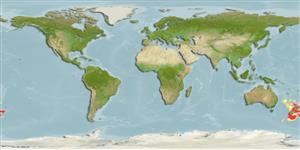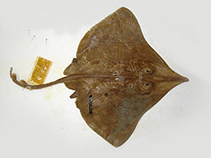Dipturus innominatus (Garrick & Paul, 1974)
New Zealand smooth skate
Add your observation in Fish Watcher
| Native range | All suitable habitat | Point map | Year 2050 |

|
| This map was computer-generated and has not yet been reviewed. |
| Dipturus innominatus AquaMaps Data sources: GBIF OBIS |
Upload your photos and videos
Pictures | Google imageDipturus innominatus
Picture by Duffy, C.
Pictures | Google imageDipturus innominatus
Picture by Duffy, C.
New Zealand country information
Common names:
Smooth skate, Uku
Occurrence: endemic
Salinity: marine
Abundance: occasional (usually not seen) | Ref: Doonan, I.J., M. Dunn and A.C. Hart, 2009
Importance: commercial | Ref: Armitage, R.O., D.A. Payne, G.J. Lockley, H.M. Currie, R.L. Colban, B.G. Lamb and L.J. Paul (eds.), 1994
Aquaculture: | Ref:
Regulations: | Ref:
Uses: no uses
Comments: Occurs throughout New Zealand, usually in deeper waters to 200 m (Ref. 9258). Recorded in trawl surveys in Chathams Island (Ref. 45493) and off the east coast of South Island (Ref. 58461). Caught throughout the year, mainly with trawls but also with lines (Ref. 9258). Exported to Europe, especially France. Voucher specimen(s) held at the NMNZ (Ref. 5755).
National Checklist:
Country Information: https://www.cia.gov/library/publications/resources/the-world-factbook/geos/nz.html
National Fisheries Authority: http://www.fish.govt.nz/
Occurrences: Occurrences Point map
Main Ref: Cox, G. and M. Francis, 1997
National Database:
Occurrence: endemic
Salinity: marine
Abundance: occasional (usually not seen) | Ref: Doonan, I.J., M. Dunn and A.C. Hart, 2009
Importance: commercial | Ref: Armitage, R.O., D.A. Payne, G.J. Lockley, H.M. Currie, R.L. Colban, B.G. Lamb and L.J. Paul (eds.), 1994
Aquaculture: | Ref:
Regulations: | Ref:
Uses: no uses
Comments: Occurs throughout New Zealand, usually in deeper waters to 200 m (Ref. 9258). Recorded in trawl surveys in Chathams Island (Ref. 45493) and off the east coast of South Island (Ref. 58461). Caught throughout the year, mainly with trawls but also with lines (Ref. 9258). Exported to Europe, especially France. Voucher specimen(s) held at the NMNZ (Ref. 5755).
National Checklist:
Country Information: https://www.cia.gov/library/publications/resources/the-world-factbook/geos/nz.html
National Fisheries Authority: http://www.fish.govt.nz/
Occurrences: Occurrences Point map
Main Ref: Cox, G. and M. Francis, 1997
National Database:
Common names from other countries
Classification / Names Nombres comunes | Sinónimos | Catalog of Fishes(Género, Especie) | ITIS | CoL | WoRMS | Cloffa
Elasmobranquios (tiburones y rayas) (sharks and rays) > Rajiformes (Skates and rays) > Rajidae (Skates)
Etymology: Dipturus: Greek, di = two + Greek, pteryx = fin (Ref. 45335).
Etymology: Dipturus: Greek, di = two + Greek, pteryx = fin (Ref. 45335).
Environment: milieu / climate zone / depth range / distribution range Ecología
marino demersal; rango de profundidad 15 - 1310 m (Ref. 26346). Deep-water; 33°S - 43°S, 166°E - 178°W (Ref. 114953)
Distribución Países | Áreas FAO | Ecosistemas | Ocurrencias, apariciones | Point map | Introducciones | Faunafri
Southwest Pacific: endemic to New Zealand.
Length at first maturity / Tamaño / Peso / Age
Maturity: Lm 112.0 range ? - ? cm
Max length : 240 cm TL macho / no sexado; (Ref. 26346); common length : 80.0 cm TL macho / no sexado; (Ref. 9258); edad máxima reportada: 24 años (Ref. 47618)
Max length : 240 cm TL macho / no sexado; (Ref. 26346); common length : 80.0 cm TL macho / no sexado; (Ref. 9258); edad máxima reportada: 24 años (Ref. 47618)
Short description Claves de identificación | Morfología | Morfometría
Grey with scattered charcoal blotches dorsally, greyish-white ventrally (Ref. 26346).
Occurs in coastal waters, continental shelf and upper slope (Ref. 26346). Usually found in deeper waters to 200 m (Ref. 9258). Mainly feeds on benthic decapods and bony fishes (Ref. 114953). Oviparous (Ref. 50449). Eggs have horn-like projections on the shell (Ref. 205). Males reaches maturity at ca. 150 cm TL. This species is said to be long lived and slow growing (Ref. 114953).
Life cycle and mating behavior Madurez | Reproducción | Puesta | Huevos | Fecundidad | Larva
Oviparous, paired eggs are laid. Embryos feed solely on yolk (Ref. 50449). Young hatch at about 20-23 cm (Ref. 26346).
Main reference
Upload your references | Referencias | Coordinador : McEachran, John | Colaboradores
McEachran, J.D. and K.A. Dunn, 1998. Phylogenetic analysis of skates, a morphologically conservative clade of elasmobranchs (Chondrichthyes: Rajidae). Copeia 1998(2):271-290. (Ref. 27314)
Threat to humans
Harmless
Human uses
Pesquerías: comercial
FAO(Publication : search) | FishSource | Sea Around Us
Más información
Trophic ecology
componentes alimenticios
Composición de la dieta
consumo de alimento
Food rations
Despredadores
componentes alimenticios
Composición de la dieta
consumo de alimento
Food rations
Despredadores
Ecology
Ecología
Home ranges
Ecología
Home ranges
Population dynamics
Coeficiente del crecimiento para
Max. ages / sizes
Length-weight rel.
Length-length rel.
Length-frequencies
Mass conversion
Reclutamiento
Abundancia
Coeficiente del crecimiento para
Max. ages / sizes
Length-weight rel.
Length-length rel.
Length-frequencies
Mass conversion
Reclutamiento
Abundancia
Life cycle
Reproducción
Madurez
Fecundidad
Puesta
Spawning aggregations
Huevos
Egg development
Larva
Dinámica larvaria
Reproducción
Madurez
Fecundidad
Puesta
Spawning aggregations
Huevos
Egg development
Larva
Dinámica larvaria
Physiology
Body composition
Nutrients
Consumo del oxígeno
Tipo de natación
Velocidad de natación
Visual pigments
Fish sound
Diseases & Parasites
Toxicity (LC50s)
Body composition
Nutrients
Consumo del oxígeno
Tipo de natación
Velocidad de natación
Visual pigments
Fish sound
Diseases & Parasites
Toxicity (LC50s)
Genetics
Genética
Heterozygosity
heritabilidad
Genética
Heterozygosity
heritabilidad
Human related
Aquaculture systems
Perfiles de acuicultura
Razas
Ciguatera cases
Stamps, coins, misc.
Aquaculture systems
Perfiles de acuicultura
Razas
Ciguatera cases
Stamps, coins, misc.
Herramientas
E-book | Guía de campo | Asistente para frecuencias de tallas | Herramienta de ciclo de vida | Mapa de puntos | Classification Tree
| Catch-MSY |
Special reports
Download XML
Fuentes de Internet
Aquatic Commons | BHL | Cloffa | Websites from users | Check FishWatcher | CISTI | Catalog of Fishes(Género, Especie) | DiscoverLife | ECOTOX | Faunafri | Fishtrace | GenBank(genome, nucleotide) | GloBI | GOBASE | | Google Books | Google Scholar | Google | IGFA World Record | MitoFish | Otolith Atlas of Taiwan Fishes | PubMed | Reef Life Survey | Scirus | SeaLifeBase | Árbol de la vida | Wikipedia(Go, búsqueda) | World Records Freshwater Fishing | Expediente Zoológico
Estimates based on models
Preferred temperature (Ref. 115969): 6.4 - 12.9, mean 8.2 (based on 173 cells).
Phylogenetic diversity index (Ref. 82804): PD50 = 0.5000 [Uniqueness, from 0.5 = low to 2.0 = high].
Bayesian length-weight: a=0.00224 (0.00133 - 0.00376), b=3.24 (3.10 - 3.38), in cm Total Length, based on LWR estimates for this species & Genus-body shape (Ref. 93245).
Nivel trófico (Ref. 69278): 4.1 ±0.6 se; based on size and trophs of closest relatives
Resiliencia (Ref. 120179): Bajo, población duplicada en un tiempo mínimo de 4.5-14 años (Fec assumed to be <100).
Fishing Vulnerability (Ref. 59153): Very high vulnerability (80 of 100).




